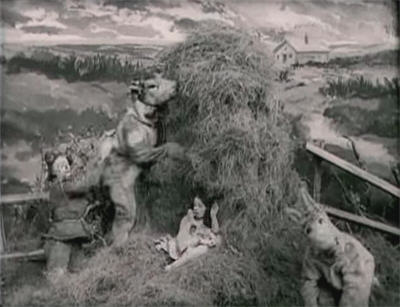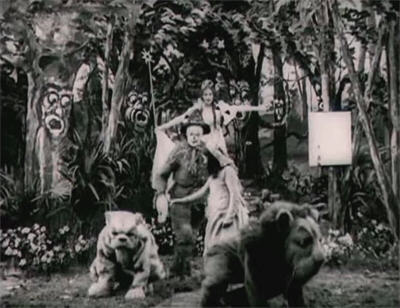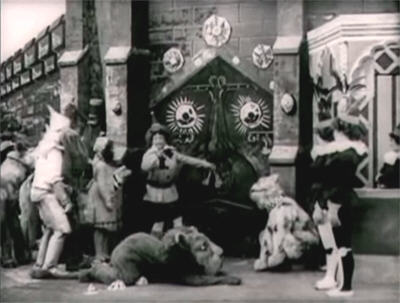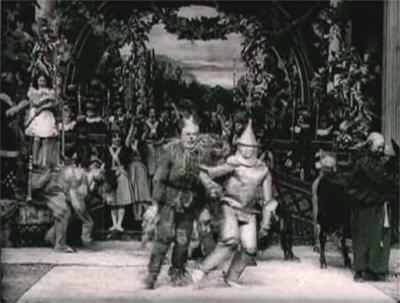
“Dorothy reaches the Emerald City to claim the crown…”
Director: Otis Turner
Starring: Bebe Daniels, Hobart Bosworth, Robert Z. Leonard, Alvin Wyckoff, Winifred Greenwood, Olive Cox, Eugenie Besserer, Lilian Leighton
Screenplay: Otis Turner, based upon the novel and stage-play by L. Frank Baum
Synopsis: Dorothy Gale (Bebe Daniels) discovers that the scarecrow (Robert Z. Leonard) out in her family’s cornfield is alive. She helps him down off his post. Even as the scarecrow thanks her, a cyclone begins to build. The scarecrow helps Dorothy, her dog, Toto, Hank the mule and Imogene the cow take shelter in a haystack, but the storm lifts all of them into the air, carrying them from Kansas to the Land of Oz. They land in a forest, startled but unharmed. Meanwhile, in the Emerald City, the Wizard of Oz (Hobart Bosworth), who is also the land’s reluctant king, is being held in thrall by Momba the Wicked Witch (Winifred Greenwood); he issues a proclamation offering the crown to anyone who can free him. In the forest, Dorothy plays with Toto, unaware of a threat in the shape of a lion. Fortunately, Glinda the Good Witch (Olive Cox) is nearby. She turns Toto from a small dog into a man-sized one. As the lion attacks, Toto fights with and subdues him; the two then make friends. Dorothy sees a copy of the Wizard’s proclamation, and the band sets out to find Momba…
Comments: Lyman Frank Baum’s novel, The Wonderful Wizard Of Oz, was published in the year 1900 to critical acclaim and high sales. Its widespread popularity and colourful characters made it prime material for stage adaptation, and in 1901 Baum entered into a partnership with producer Frederick Hamlin and director Julian Mitchell to develop a live version of his story.


However, Baum’s first script was rejected outright by the pair, who sent him away with an outline of their own devising, which he reluctantly adapted. The result was a lively pantomime filled with song after song, which bore only the vaguest resemblance to the novel upon which it was supposedly based. As it turned out, however, the commercial instincts of Hamlin and Mitchell were entirely correct: the stage musical, The Wizard Of Oz, which opened in Chicago in 1902 and moved to Broadway in 1903, was a smash hit. It ran on Broadway for nearly two years, and toured the country as a road show into the next decade.
Baum had written other stories before the publication of his breakthrough novel, and continued to do so afterwards, resisting public and publisher pressure to write a second tale of Oz. However, for most of his adult life Baum was plagued by financial trouble—losing jobs, starting numerous businesses that failed, and mismanaging the money that his literary successes brought in. In 1904, he bit the bullet and wrote The Marvellous Land Of Oz—and, proving that he had learned at least something from experience, did so envisioning its eventual adaptation for the stage.
(It is because of this that the Emerald City has an all-female army: chorus lines, you understand.)
The most popular aspect of the stage version of The Wizard Of Oz was the co-casting of vaudeville partners Fred Stone and David C. Montgomery as the Scarecrow and the Tin Woodman, respectively. For this reason, Baum made these two characters especially prominent in his sequel, assuming that Stone and Montgomery would willingly reprise their roles for him, only to find that the two had no intention of leaving the touring company of the original play.

In desperation, Baum wrote The Woggle-Bug, a stage musical based upon some of the supporting characters from The Marvellous Land Of Oz, with the Scarecrow and the Tin Woodman essentially replaced with Jack Pumpkinhead and the titular man-sized insect (a scholar and a gentleman, at least at that point in his incarnation). The musical was not a success, most critics dismissing it as a substandard rip-off of its predecessor, and it closed after less than a month.
By this time, Baum had accepted his fate: he would turn out an Oz book a year for the rest of his life, each time threatening that that novel would be the last. (Perhaps inevitably, the final Baum-penned Oz novel, Glinda Of Oz, was published posthumously.) Baum was also involved in the first attempt to bring the Oz stories to the motion picture screen, writing and producing The Fairylogue And Radio Plays, a complex mixture of live action and film – the latter of which was hand-tinted by the French Company Duval Frères, the world leaders in such techniques – that also involved Baum himself interacting with his characters, both in the flesh and onscreen.
The shows were successful, but not successful enough; they could not be. Put simply, with their early multi-media aspects and enormous cast, plus the expense of the hand-tinting, the shows cost more to stage than they could re-coup even with sell-out audiences. They ran for less than two months during 1908, and by the end of the year Baum was once again in dire financial straits. His situation left him with little chance of dictating terms when the Selig Polyscope Company, which had been involved in the production of The Fairylogue And Radio Plays, announced its intention of recovering its losses by adapting Baum’s stories for the screen.


Left with no choice, Baum agreed to the arrangement but played no role in production. Over a three month period in 1910, Selig made and released The Wonderful Wizard Of Oz, Dorothy And The Scarecrow In Oz and The Land Of Oz, as well as producing John Dough And The Cherub, based upon more of Baum’s tales, later the same year. The latter three are all lost; the first is the oldest surviving film adaptation of the Oz stories.
One wonders how Frank Baum felt about the fact that The Wonderful Wizard Of Oz was not, in fact, an adaptation of his novel, but an adaptation of the stage play – at least to a point. Of course, the play was famous and popular for its songs; with these necessarily eliminated, writer-director Otis Turner reinserted into his script the Wicked Witch of the West, who had been left out of the play in order to keep its tone light.
(That said, the play climaxes with Dorothy & Co. convicted of treason and facing execution. I guess “light” is in the eye of the beholder.)
The film, running approximately thirteen minutes, is brisk to the point of incoherence. All the animals – with the exception of the brief appearance of a real Toto – are of the pantomime variety, and seem to be there chiefly to ensure that the image is never still for a moment. Whatever the main action of a scene, the animals will generally be capering on its fringes. Similarly, there is much exuberant action and dancing from Momba’s servants – tumbling black-clad figures that seem inspired by Georges Méliès, and others that are supposed to be flying lizards – and from the throne-room guards in the Emerald City (who, in the film’s most bizarre sequence, unionise). The acting is similarly energetic, consisting of constant wild gesticulation and much slapstick tumbling. The overall effect is rather exhausting.


Naturally enough, the various special effects used in The Wonderful Wizard Of Oz are primitive, but engaging in their ingenuity. Harness-work flying scenes are plentiful, and amusingly obvious. The cyclone that whisks Dorothy from Kansas – that’s right, cyclone; this particular atmospheric disturbance may since have been immortalised as a twister, but in the novel it is actually a cyclone, and that’s what they call it here – is achieved by a rotating backdrop, meant to convey the rushing of the clouds.
Many of the settings are likewise more like stage backdrops that movie sets, but are nevertheless well done, particularly the woodland cottage belonging to Momba the Wicked Witch. She, by the way, when meeting her watery date with destiny, does not melt as her screen descendant famously does, but instead fades slowly away. My favourite touch, however, is the faces on the trees in the forest in which Dorothy and her companions land which, while they do not move, are marvellously expressive, and exhibit exactly the right degree of shock and alarm as they stand silent witnesses to the appearance of Glinda and panto-Toto’s fight with the Lion (who is no coward in this version).
The plot of The Wonderful Wizard Of Oz is perfunctory at best, with lots of sudden leaps and unexplained actions—so you’ll forgive me if this recap contains frequent uses of words like “evidently” and “apparently”. Perhaps the oddest thing, dramatically speaking, is that Kansas turns out to be already populated with pantomime animals, and to contain a living scarecrow. While Uncle Henry, Auntie Em and the hands struggle with Hank the mule, Dorothy ends up in a cornfield, where the Scarecrow suddenly speaks to her. Recovering from her shock, Dorothy helps him down, and he immediately takes a tumble over a turnstile.


Almost at the same moment, the storm begins to build. Dorothy is accompanied in this scene by Toto the dog (a real dog), Imogene the cow (not a real cow) and – hmm – Hank the mule, and all five take refuge in a haystack. The cyclone picks up the entirety of this flimsy shelter, whirling it around and around, and deposits its occupants in Oz, breathless but otherwise unharmed.
As the accidental tourists congratulate themselves on their safe landing, we cut to the Emerald City, where a title card informs us that, Momba the witch exerts her power over the Wizard of Oz, although we are given no hint of how the Wizard came to be in Momba’s power in the first place, nor do we see much evidence of her “exertion”. That is, she shows up, sends everyone but the Wizard scampering from the throne-room, gives the Wizard a hot-foot – no, really – threatens him with her broom, and conjures up her own tumbling minions; but having done so, she then flies off again.
In any case, the Wizard – who is also king of Oz – is fed up, and issues a proclamation offering the throne to anyone who can free him from Momba’s spell. He also declares his desire to return to Omaha, and admits that, as a wizard, he is a complete humbug; adding with perfect chop-logic that he is including this admission in the proclamation in order to keep the fact a secret.
Back in the forest, Dorothy is playing with Toto, of whom we shall not see much more, at least not in his own persona. Canina?


In the film’s best-staged scene, as Dorothy plays with Toto, the Lion appears in the bushes to her left and behind her. Meanwhile, behind both of them and to their right, Glinda the Good Witch glides into shot from below; and all the while, those trees look on worriedly.
Just as the Lion lunges at Dorothy, Glinda transforms the real Toto into a man-sized version of himself; the dog leaps bravely at the Lion and subdues him, but Dorothy intervenes before he can do any real damage. At Dorothy’s insistence, the combatants then hug and make up, but will nevertheless continue to scrap intermittently throughout the rest of the film.
Peace restored, Dorothy and the Scarecrow notice a copy of the Wizard’s proclamation nailed to a nearby tree. The companions decide to take up this challenge; or anyway, I assume they do, since they end up at Momba’s cottage. On the way, they come across the Tin Woodman, and oil him back to life. A celebratory passage follows as the Tin Woodman plays his piccolo – as he did in the novel – and the Scarecrow dances and tumbles. The animals join in, and then so does Dorothy. In the middle of this sequence, yet another panto-animal, Eureka the kitten (a character introduced in Baum’s Dorothy And The Wizard In Oz, published in 1908), appears for no readily apparent reason and joins up with the travellers, who march off arm in arm, two by two. So I guess Eureka is there to even up the numbers.
We then cut to Momba’s cottage, a charming fairy-tale creation with a garden of magic mushrooms, where her various minions fly and tumble to no particular end. Our intrepid travellers stagger in in a state of panic – okay, not so intrepid – having been captured by still more minions; so perhaps they weren’t deliberately seeking Momba at all..


With hilarious abruptness, a title card then informs us baldly that, Dorothy learns that water is fatal to a witch—although whether the subsequent bucket-load is delivered out of intention or just temper is left unclear. Anyway, Dorothy and the others are prisoners inside Momba’s cottage (which is TARDIS-like in its dimensions). Momba – rather unwisely, one would have to say – is forcing Dorothy to wash her floors when her bullying treatment of the girl has the inevitable effect: SPLOOSH.
Dorothy cringes back in terror of the consequences, but she has nothing to fear: Momba simply fades away, leaving behind her only the Golden Cap. (In the novel, this cap allows whoever owns it to control the Flying Monkeys.) The Tinman frightens off the minions, and the Scarecrow reminds Dorothy of the Wizard’s proclamation. The travellers then set out for the Emerald City, bearing the Golden Cap as proof of Momba’s demise
The Wizard is delighted to meet his deliverers, and offers his crown to Dorothy. She declines it, however, and insists that the Scarecrow be made king. Much dancing, tumbling, capering and arm-waving follows, before the Wizard prepares to depart by balloon for Nebraska. A fly enters the ointment when a clock strikes midday, and those helping build the balloon immediately walk off the job, their leader (hilariously billed as “Union Enforcer”) planting a sign that declares, Union rules: no work after 12:00.
The worker-girls then form a chorus line and celebrate their industrial relations victory by dancing and skipping off. The Wizard is devastated by this uprising of the masses, but Dorothy laughs uproariously. Dirty little Commie.


Nevertheless, the Wizard is soon boarding his balloon for takeoff. Whether Dorothy was meant to go with him isn’t clear – there is a moment when the Scarecrow and the Tin Woodman lift her up – but if she is upset at being left behind in Oz, she doesn’t subsequently show it.
The Wonderful Wizard Of Oz concludes with a parade of Random Oddness: costumed riders on horses trot across the frame; black guys in nappies leading camels bearing veiled women follow; and the Scarecrow and the Tin Woodman do a dance as everybody else capers, cheers and waves their arms, including Dorothy. The End.
Primitive and wildly uneven as it is, The Wonderful Wizard Of Oz has a certain charm, even aside from its historical significance. It helps to be tolerant of the conventions of pantomime, however.
I should mention that the cast and crew information provided here comes under the heading of “best guess”: between a lack of hard information and a surfeit of argument, the names provided are those currently accepted, rather than what is known for certain. And there are some familiar and influential names amongst the presumed cast. Bebe Daniels, nine years old when this film was made, is probably best known these days as the Broadway star who loses her role to Ruby Keeler in 42nd Street. Eugenie Besserer, Winifred Greenwood and Lillian Leighton (the “Union Enforcer”) all had lengthy careers; while Alvin Wyckoff (the Tin Woodman) later became a cinematographer, and worked well into the 1940s. Hobart Bosworth was an important figure in early cinema, helping to establish the Selig Polyscope Company, where he was an actor, a writer and a director, on the west coast before breaking away to form his own production company.


Perhaps the most significant name here, however, is that of Robert Z. Leonard, who gives as energetic performance as the perpetually tumbling Scarecrow: like Hobart Bosworth – indeed, like many of the silent era – Leonard would work at acting, writing and directing before at length establishing himself at MGM, where he would win a reputation as one of the most reliable of the studio’s “house” directors and be twice nominated for Academy Awards.
The Wonderful Wizard Of Oz well-received by both critics and the public, as were its sequels; a fact that probably helped to inspire the next phase of L. Frank Baum’s disastrous business career…

It’s always interesting to see the competition of book vs. movie (and between movies). Unfortunately, the movie always wins in the mind of the public. (SPOILER ALERT – the Little Mermaid was trying to gain a human soul by marrying the prince, and she dies in the end (sort of)).
LikeLike
Not to mention the charming bit when she nearly tears herself in two…
LikeLike
Very interesting account. However, concerning “conventions of pantomine”, I always understood pantomime to be a strictly British phenomenon. Indeed, I never heard of it before encountering it in Monty Python and the Goon Show. Maybe Selig’s immediate inspiration was European film, but I imagine it was all new to the audience.
I love those set/backdrops.
LikeLike
It was certainly a long-standing British tradition, but it wasn’t “strictly” British in the sense of only ever existing in Britain. There were American vaudeville acts which were derived from it, and those evolved into the sort of stage productions of which the musical version of The Wizard Of Oz is a prime example; and these in turn got transferred to film in the early days, before developing special effects technology sent film fantasy in a different direction.
LikeLiked by 1 person